Introduction
In the fast-paced world of trading, where fortunes are made and lost in the blink of an eye, one factor reigns supreme: risk management. While traders often obsess over entry points and technical analysis, the true hallmark of a successful trader lies in their ability to manage risk and handle drawdowns effectively. In this systematic trader’s guide, we will explore the art of risk management and the crucial role it plays in achieving consistent profitability in the markets.
The Myth of Technical Skill
Contrary to popular belief, technical skill is not the primary determinant of trading success. It is not the secret sauce that separates great traders from the rest of the pack. Instead, the real differentiator is a trader’s emotional discipline and adherence to sound risk management rules.
Position Sizing: The Cornerstone of Risk Management
Imagine a trader named Sunny who starts with a capital of Rs. 5,00,000. He buys 5,000 shares of company ABC at Rs. 100 each. When the stock surges to Rs. 110, he makes a quick profit and feels on top of the world. However, what if the stock drops to Rs. 90, then Rs. 88, and finally to Rs. 80? Panic sets in, and Sunny ends up losing a significant portion of his capital.
Sunny’s mistake was not in picking the wrong stock but in the size of his trade. The lesson here is clear: size matters. To determine the appropriate position size, traders should follow these rules:
- Capital: Rs. 10,000
- Entry Price: Rs. 100
- Stop Loss: Rs. 90
- Risk: Rs. 10 (C – B)
- Risk Limit: 2% of capital (2% of Rs. 10,000 = Rs. 200)
- Number of Shares: Rs. 200 / Rs. 10 = 20 shares
By adhering to these rules, Sunny limits his potential loss to just 2% of his capital, allowing him to trade with confidence and discipline.
Read: Intraday Trading – Mastering the Art of Timing for Maximum Profits
Scaling Up Gradually
Traders often make the mistake of increasing their position size too quickly after a successful run. However, this can lead to emotional turmoil and a return to their previous position size. Gradual, controlled increases in position size based on risk percentage are advisable to minimize drawdowns and maintain consistency in trading.
Conquering Drawdowns: The Trading Olympian’s Way
Drawdowns are the trader’s worst enemy, capable of eroding confidence and causing panic. A drawdown refers to the decline in an account’s value from its peak before it recovers. Warren Buffett’s famous quote emphasizes the importance of resilience in trading. Still, it’s easier said than done.
Drawdowns lead to numerous psychological pitfalls:
- Doubting the system’s effectiveness.
- Suspecting changes in market conditions.
- Questioning personal competence.
Time Drawdown: A Crucial Metric
To navigate drawdowns successfully, traders must consider not only the magnitude but also the duration of drawdowns. Knowing how long a trading strategy can remain underwater when market conditions change is essential. For example, in 2017, many intraday trend followers suffered prolonged drawdowns due to historically low volatility.
When designing a trading system, traders should scrutinize both returns and drawdowns. If a backtest indicates a 15% drawdown, be prepared for a 30% drawdown in live trading. Equally important is assessing how often the equity remains underwater for extended periods.
Conclusion
In the world of systematic trading, risk management and drawdown handling are the unsung heroes of success. Position sizing, gradual scaling, and understanding drawdowns are the keys to maintaining your composure and achieving consistent profitability. Remember, in trading, as in life, it’s not about avoiding storms but learning to navigate them skillfully. So, equip yourself with the tools of risk management, and you’ll be on your way to becoming a trading Olympian.
Disclaimer: This blog has been written exclusively for educational purposes. The securities mentioned are only examples and not recommendations. It is based on several secondary sources on the internet and is subject to changes. Please consult an expert before making related decisions.


